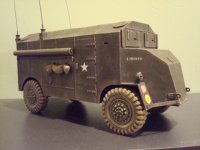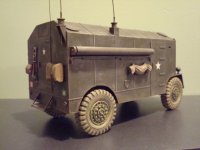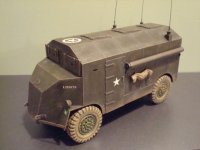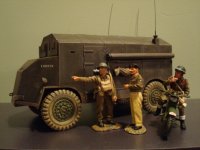wlindsay
Private
- Joined
- Apr 13, 2008
- Messages
- 22
Hi Guys,
I've attached some photos of my latest project, an AEC Dorchester Armoured Command Vehicle.
Vehicle
-Manufactured by the Associated Equipment Company (AEC)and based on the Matador 4x4 151"wheelbase.
-Used by Armoured Division HQ as a lower power wireless control terminal for communications at the corps and division level. Also served as an office for members of the division staff. Normally there were around 20 of these vehicles assigned each Armoured Division.
-Equipment consisted of a No. 19 wireless set, a No.19 set with linear amplifier, generator and batteries. Standard armament protection was provided by a .303 bren gun, .45 Submachine gun and Rifles. The body has 2 compartments, the forward one with 3 seats, mapboard and headphones for use by Staff officers. Rear Compartment was used for wireless operations.
Armour thickness- Rad cover 10mm, Body Sides and Rear 12mm, Roof 5mm
I found information on this vehicle to be less than forthcoming. I was actually able to dig up more information and photos of the the this vehicle in German service. No less than 3 of these "Mammuts" were captured by the Afrika Korps and pressed into service At least one was used by Rommel himself.
Model
The intent of the project was to make a model that would complement my K&C soldiers and vehicles in 1/30 scale. I didn't want to get too bogged down in all the detail typically associated with 1/35th modeling. My experience is that obsessive details can slowdown and even kill a modeling project. I just wanted to make something that looked to be a reasonable representation of the original vehicle. It is missing a "few rivets", but that's by choice.
The model is scratchbuit from 1mm (0.040") thick polystyrene sheet and detailed with various sizes and shapes of polystyrene strip. It was based on a plan drawing by George Bradford.(http://www.geocities.com/firefly1002000/)
The wheels were "expropriated" from one of my K&C Staghounds DD060 (a beautiful model in its own right!).These were the only wheels that I could find that were about the correct size. The headlamps, tarps and tools were all scavanged from my spare parts box.
My interest has long been in the wheeled vehicles used by the Canadian and Commonwealth Armies in WWII, so, I chose to build my model to represent a Dorchester ACV in Canadian service .
The model was Painted with Tamiya Olive Drab, weathered with graphite and finally dry brushed with Testors Brown and Tan.
The markings are Archer Dry Transfers for the 4th Canadian Armoured Division. As I mentioned earlier, photos of this vehicle were hard to come by, so the markings are more or less a guess on my part.
It took me about 25 working hours to complete the model. (It took longer to plan out and motivate myself to to start it!)
It was an enjoyable project and I feel it turned out fairly well. It will be a nice addition to my collection. The only "regret" I have with the project is taking the wheels from the Staghound. It's always tough to "sacrifice" a nice model for parts and as prices rise, it can get expensive. I'll probably try to make a mold and cast some duplicates in the future, but that is another project for another day. In the meantime, I left the wheels in the original paint so that they could easily be put back on the Staghound if ever needed.
I hope you enjoy the photos.
Regards,
Wayne
I've attached some photos of my latest project, an AEC Dorchester Armoured Command Vehicle.
Vehicle
-Manufactured by the Associated Equipment Company (AEC)and based on the Matador 4x4 151"wheelbase.
-Used by Armoured Division HQ as a lower power wireless control terminal for communications at the corps and division level. Also served as an office for members of the division staff. Normally there were around 20 of these vehicles assigned each Armoured Division.
-Equipment consisted of a No. 19 wireless set, a No.19 set with linear amplifier, generator and batteries. Standard armament protection was provided by a .303 bren gun, .45 Submachine gun and Rifles. The body has 2 compartments, the forward one with 3 seats, mapboard and headphones for use by Staff officers. Rear Compartment was used for wireless operations.
Armour thickness- Rad cover 10mm, Body Sides and Rear 12mm, Roof 5mm
I found information on this vehicle to be less than forthcoming. I was actually able to dig up more information and photos of the the this vehicle in German service. No less than 3 of these "Mammuts" were captured by the Afrika Korps and pressed into service At least one was used by Rommel himself.
Model
The intent of the project was to make a model that would complement my K&C soldiers and vehicles in 1/30 scale. I didn't want to get too bogged down in all the detail typically associated with 1/35th modeling. My experience is that obsessive details can slowdown and even kill a modeling project. I just wanted to make something that looked to be a reasonable representation of the original vehicle. It is missing a "few rivets", but that's by choice.
The model is scratchbuit from 1mm (0.040") thick polystyrene sheet and detailed with various sizes and shapes of polystyrene strip. It was based on a plan drawing by George Bradford.(http://www.geocities.com/firefly1002000/)
The wheels were "expropriated" from one of my K&C Staghounds DD060 (a beautiful model in its own right!).These were the only wheels that I could find that were about the correct size. The headlamps, tarps and tools were all scavanged from my spare parts box.
My interest has long been in the wheeled vehicles used by the Canadian and Commonwealth Armies in WWII, so, I chose to build my model to represent a Dorchester ACV in Canadian service .
The model was Painted with Tamiya Olive Drab, weathered with graphite and finally dry brushed with Testors Brown and Tan.
The markings are Archer Dry Transfers for the 4th Canadian Armoured Division. As I mentioned earlier, photos of this vehicle were hard to come by, so the markings are more or less a guess on my part.
It took me about 25 working hours to complete the model. (It took longer to plan out and motivate myself to to start it!)
It was an enjoyable project and I feel it turned out fairly well. It will be a nice addition to my collection. The only "regret" I have with the project is taking the wheels from the Staghound. It's always tough to "sacrifice" a nice model for parts and as prices rise, it can get expensive. I'll probably try to make a mold and cast some duplicates in the future, but that is another project for another day. In the meantime, I left the wheels in the original paint so that they could easily be put back on the Staghound if ever needed.
I hope you enjoy the photos.
Regards,
Wayne






